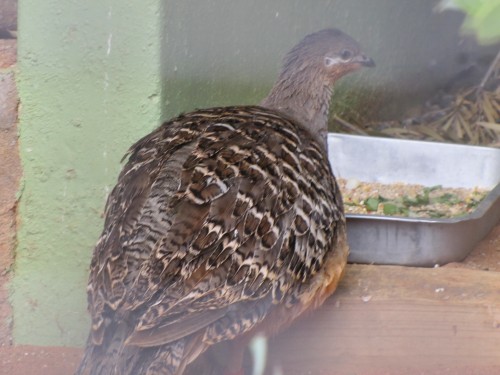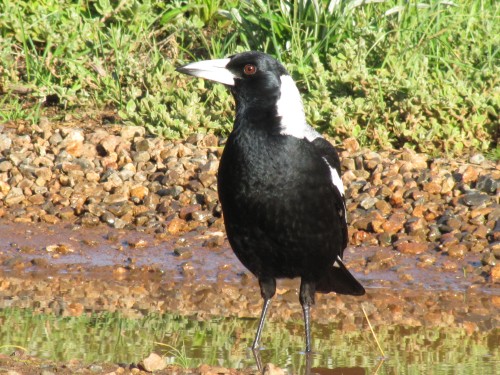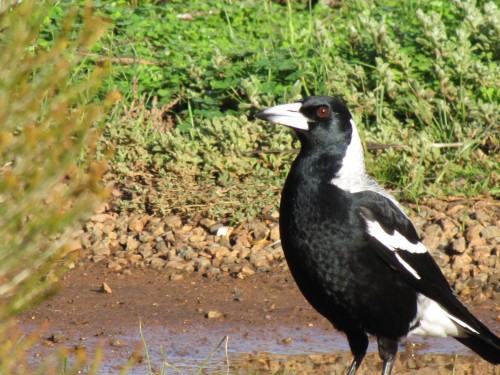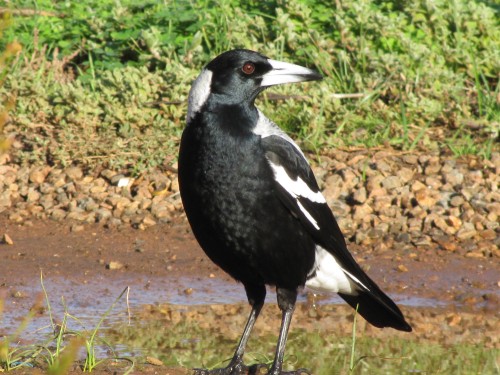Beautiful Mistletoebird
One of my favourite birds is the colourful little Mistletoebird, shown in today’s photo. I can’t say it is a resident species in our garden, but it is a frequent visitor. In our district here in Murray Bridge, South Australia, it is a widespread species occurring in small numbers. They are usually only seen singly, occasionally two.
Today my wife and I were working in our garden and a male landed briefly in a nearby Eremophila bush. It stayed only a few seconds before flying off. The male, as shown in the photo, is far more brightly coloured than the female. In the female, the red is a washed out colour and only present under the tail. She also lacks the dark blue-black colour of the male, being mainly plain brown instead.
As I didn’t have my camera with me today, the photo shown above was taken some years ago, also in our garden.
This species has a special place in our records for our home block. Over the 30 years we have lived here we have planted hundreds of trees, shrubs and bushes. The mistletoebird was the first species to make a nest in a tree we had planted. At least – it was the first one we noticed.
Malleefowl in the Adelaide Zoo
The Malleefowl, a turkey-sized mound building bird of the drier parts of Australia, is a widespread but uncommon bird living in the region where I live. It is primarily a ground dwelling bird, feeding mainly on seeds. The male makes a large 2 to 3 metre wide mound of sand and vegetation like leaves, grass, bark and so on which acts like a compost heap.
The rotting vegetation develops heat which incubates the eggs the female lays and buries in the mound. The male works the mound daily during the summer months, adding or removing soil to regulate the temperature in the egg chamber. Not surprisingly, this bird is also known as the Incubator Bird. In all my years of birding I have only seen about a dozen of this species, but amazingly, I saw 6 in a one hour period.
The bird in the photo above is a captive bird in the Adelaide Zoo.
White Stork, Rabat, Morocco
During our visit to Morocco we briefly visited the capital city, Rabat. One of the features of our short stay was a visit to the ancient Roman ruins of Sala Colonia. These old ruins were fascinating and the oldest historic buildings my wife and I had ever seen, though that was to change in the coming weeks.
From a birding point of view there were a few birds around but my main interest was in looking at the ruins and listening to our guide. The most prominent birds present were quite a number of White Storks on their nests, always perched on a high vantage spot. White Storks are large birds, measuring over a metre in height and with a wingspan of about two metres. Their prominent red bills and red legs stand out against their mostly white feathers – there is some black on the wings.
This was a new species for me and a delight to see, though it would be a common sight not only in Morocco but in many parts of Africa, Europe and even south western Asia. The massive nests are not easily overlooked either.
Are the magpies getting ready to start nesting?
Australian Magpies are one of the most recognisable of Australian birds. They are common over large parts of Australia.
They are also highly territorial, and in the breeding season they can be very aggressive towards other magpies, other bird species, and, on occasions, towards humans. Their swoop – usually from behind and usually unexpected – can be quite terrifying to some people. They have been know to even draw blood if contact is made with vulnerable parts such as the head. Cyclists seem to attract swooping magpies far more than pedestrians, for some reason.
About this time of the year, however, they generally have not yet started nesting. Now is the time to reinforce their territorial claims, chasing one another in wild, noisy conflicts. I witnessed the start of this only a few days ago in our mallee scrub. Our five acre patch of scrub is the junction of three different magpie territories; the boundaries are fiercely defended. On the positive side, “our” resident magpies never swoop, for which we are thankful.
On my evening walk yesterday I heard the distinctive warning call of a male magpie, one whose territory is about a kilometre from our home. I looked up, and was interested to see a partially constructed nest in the tree over head. This particular bird is aggressive towards humans, so I’ll have to be careful walking along that part of the road in the coming weeks.
Common Starlings
The introduced bird species, Common Starling, is very common in our district, including our garden. They are also very common throughout south-eastern Australia, sometimes forming flocks numbering in the thousands.
They are a much maligned bird – and with good reason. We certainly don’t like the way they feast on the fruit in our orchard and they certainly foul up tree hollows when nesting, making the hollows most unattractive to native species.
They also have an uncanny knack of being able to imitate other birds. More than once I have been over excited about hearing an unusual call in the garden, only to realise that a starling is responsible. One of our resident starlings is able to very cleverly imitate a chook (chicken) cackling. Years ago we even had one around that was able to imitate the outside bell of a telephone, something it had learned from a nearby factory.
There is one redeeming feature of this species. At certain times of the year they do take on a very colourful, shimmering, iridescent array of colours, as shown in the birds featured in the photos today. (Hint: click on the photos to enlarge the image.)










